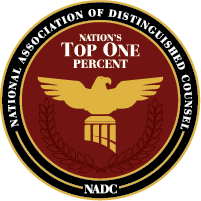Riding a bicycle should feel freeing. Unfortunately, the fear of crossing paths with vehicles that might not see you or do not understand your right-of-way is enough to keep many people off their bikes. Such concerns are far from irrational, as accidents involving bicycles at intersections are all too common.
If you were injured in a bicycle accident at an intersection, you might wonder who was at fault and how you can protect your rights. At Hollis Law Firm, we have extensive experience dealing with liability disputes and personal injury cases. We are committed to helping you navigate the legal landscape, making it easier for you to get the answers you need about your rights and options.
Common Causes of Bicycle Accidents at Intersections
Bicycle accidents at intersections are often a result of:
Failure to Yield
One of the most common causes of intersection accidents is a failure to yield. Cyclists, just like drivers, must follow the rules of the road, but not every driver understands this. Motorists may assume they have the right-of-way simply because they are in a larger vehicle, creating dangerous situations where they turn without checking for cyclists. When this happens, the results can be catastrophic for the cyclist.
Distracted Driving
Distracted driving is another major factor. Drivers who are looking at their phones, adjusting their GPS, or engaging in other activities that pull their attention away from the road often fail to notice cyclists approaching or crossing intersections. These split-second lapses in attention can cause severe accidents, leaving cyclists with life-altering injuries.
Obstructed Visibility
Intersections with poor visibility, whether due to parked cars, overgrown trees, or other obstructions, can also contribute to accidents. When drivers and cyclists can’t see each other clearly, the chance of collisions rises significantly
Right-of-Way as a Cyclist
Knowing your rights as a cyclist is crucial when navigating intersections. In most places, bicycles are considered vehicles, meaning they have the same rights and responsibilities as cars. This means you should follow all traffic signals, stop signs, and lane markings. When you approach an intersection, signal your intentions and stay visible. Remember, just because you have the right-of-way doesn’t mean drivers will always respect it.
Riding defensively can help protect you at intersections. This involves assuming not every driver will see you or understand your intentions. Make eye contact with drivers when possible, use hand signals to communicate, and be cautious when crossing, even if you have the right-of-way. Try to anticipate mistakes before they happen.
Determining Liability After an Intersection Accident
After an accident, determining liability is often dependent on traffic laws. Was the driver following the rules, or did they fail to yield when they should have? Did the cyclist obey traffic signals and lane markings? These questions are critical, and the answers can impact who is held liable. At Hollis Law Firm, we look into every detail, including witness statements and traffic camera footage, to build a comprehensive picture of what happened.
In some cases, both the driver and the cyclist may share some level of fault. This concept, known as comparative negligence, permits cyclists to pursue compensation for their damages even if they are partially responsible for the accident. For instance, if a cyclist didn’t signal a turn but the driver was speeding, both parties may share liability.
What to Do After a Bicycle Accident at an Intersection
If you are involved in an accident, be sure to prioritize your safety and get medical attention, even if you feel fine. Injuries like concussions or internal damage might not show immediate symptoms. Medical records also provide crucial evidence for your case.
Take pictures of the intersection, your bike, and any visible injuries. If there are witnesses, ask for their contact information. These details can be vital when building your case later. If law enforcement arrives, make sure to obtain a copy of the police report, as this will also be essential.
Once you have taken care of your immediate needs, reach out to an attorney experienced in cases involving personal injuries, such as those caused by bicycle accidents.
Protecting Your Rights as a Cyclist With a Hollis Law Firm Bicycle Accident Attorney
Navigating intersections can be tricky as a bicyclist, but understanding your rights and taking the proper steps after an accident can make a significant difference. Bicycle accidents at intersections often involve complex questions of liability, and having legal support can help clarify those issues.
At Hollis Law Firm, we are here to assist you in exploring your options and pursuing the compensation you deserve. For a consultation, call (800) 701-3672 or visit our contact form to get started today.



